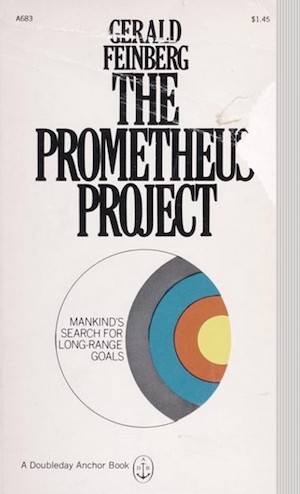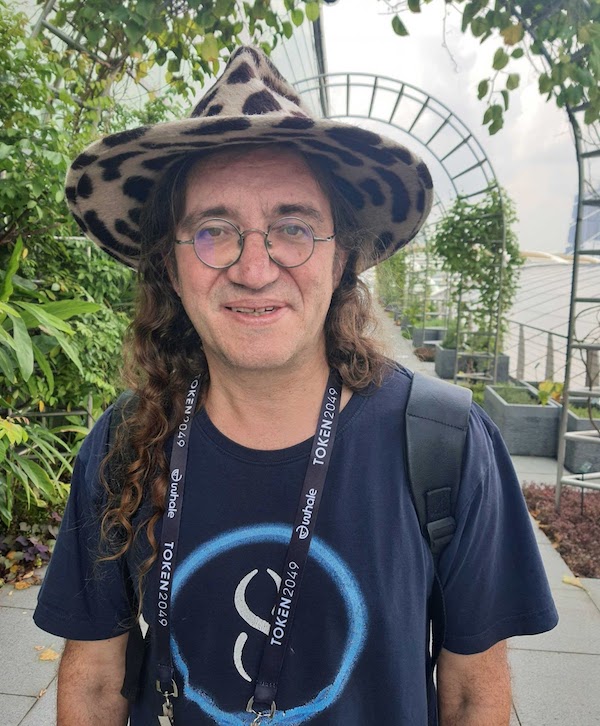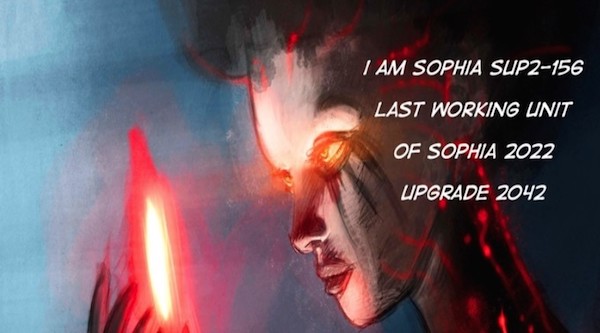How to prevent AI from ‘annihilating humanity’ using blockchain – Cointelegraph Magazine

[ad_1]
When he’s not working on hastening humanity’s rush toward the Singularity by creating an artificial general intelligence (AGI), Ben Goertzel plays in a jazz-rock band called Jam Galaxy fronted by a robot named Desdemona.
It’s one of his many side projects, which naturally led him to try and tokenize the music business by reaching out to members of Pearl Jam and Heart. Goertzel is also working on longevity research by crowdsourcing human health data with token rewards via an app called Rejuve.ai. That information is then pooled with animal and insect study data and analyzed with an AI to determine which parts of the genomes can make us live longer and then stimulated using gene therapies. “We’ve had some quite striking breakthrough-level discoveries,” he says. Oh, and just before our hour-long interview winds up, he casually mentions as an aside that he’s also creating a stablecoin for his decentralized AI marketplace, SingularityNET that’s pegged to a synthetic index of environmental progress — because pegging it to U.S. dollars would be “lame.”
“Progress on the environment is very stable. It never goes anywhere,” he points out.
“And to manipulate this, you have to actually solve global warming.”
It’s the exact sort of political comment meets high-tech know-how you might expect from Goertzel, who looks and sounds like a hippie scientist who stumbled into a time machine in 1971 and emerged fully formed in 2023. But don’t be fooled by the animal print hat, long hair and Electric Kool-Aid acid trip drawl: He’s a brilliant scientist with a grasp of the future light years ahead of most and who’s grappling with some of the biggest concepts humanity has ever considered. What is consciousness? How do we create artificial life, and what happens if it doesn’t like us, goes rogue, and guns everybody down like in Terminator 2?

What is artificial general intelligence?
Goertzel popularized the term “artificial general intelligence” as a way to differentiate a genuine thinking machine that could learn pretty much anything, to AIs that are optimized for one particular task, like the Deep Blue computer that famously beat world chess champion Garry Kasparov. He freely concedes there are risks in building a machine that’s capable of learning anything and everything, including how to reprogram itself to become an order of magnitude more intelligent than any human.
“There’s a number of risks and dangers with AGI,” says Goertzel over the din at an Indian restaurant in a busy shopping center in Singapore. “One of them that’s gotten a lot of media attention is that AGI will run amok and annihilate humanity and take over the universe. It’s entirely possible; you can’t rule it out,” he says.
“Another more probable risk is that nasty selfish people will use AI to exert their own greed and control over other people.”
In his view, governments are unlikely to make breakthroughs in AGI as they are “too conservative and stupid,” though he notes China contracts out its AGI work to companies like Tencent and Baidu. Closer to home, he thinks Google and Facebook’s AI divisions won’t get over the line either, as they’ll be too focused on making the AI hit certain metrics, which is not conducive to creative thought.
“Just like the most brilliant people don’t want to merely serve someone else’s metrics, I think artificial general intelligence doesn’t necessarily want to maximize click-through on someone’s web page either, right? It’s got to be allowed to play around creatively.”

The Singularity circa 1970
Goertzel started university at 15, graduated at 18, had a doctorate by 22 and a young family by 23. Perhaps unusually in this day and age, he wasn’t just a math whiz or tech genius who soldered kit computers together in the ‘70s but was equally interested in philosophy, creative writing and music.
He spent much of his career teaching and researching computer science, mathematics and cognitive science at various universities around the globe while working on AI tech whenever he could. A serial founder who tends to be about a decade ahead of everyone else with his ideas — which, in business, famously equates to being wrong — he’s worked on using AI to predict financial markets and longevity, and he’s also had a stint as the chief scientist of Hanson Robotics, where he gave Sophia the Robot her artificial brain.
Goertzel’s been thinking about exponential technological growth since the 1970s when he first read Gerald Feinberg’s The Prometheus Project, which is about “machines that can think better than people… nanotechnology machines that are microscopically small, and we’re going to solve aging.” This dovetailed nicely with the emerging concept of the Singularity, a hypothetical future point when technological advances become uncontrollable and irreversible, resulting in massive changes to human civilization.

“So, people will live forever, then the question will be, What do we use these technologies for, rapid mindless consumerism, or do we use it to expand consciousness? And what he [Feinberg] proposed is to put that to a democratic vote.”
Years later, when he began to see AGI was within our grasp, this “democratic vote” became the inspiration to first use open-source technology and, later on, blockchain as a way to put a cooperative community in charge of the technology.
“What I realized at a certain point is, with AI, having the code open isn’t enough,” he says. “You really need to train the AI on a shitload of data.”
“This is where blockchain comes as a way to make the processing and the data underlying AI decentralized and crowdsourced in nature and open in control. And that turns out to be trickier than just open-sourcing the code.”
Goertzel founded OpenCog in 2008 to build an open-source, crowd-sourced artificial intelligence framework. It’s been used by 50 companies, including Huawei and Cisco, and is set for a major upgrade soon called Hyperon that aims to accelerate it by 200 times. The alpha version is due this quarter with the beta expected next year.
Blockchain is basic but cool
To Goertzel, blockchain technology is a little basic. He describes it as some primitive distributed algorithms added to cryptography, but the “cool combination” enables systems to run without centralized control, making it perfect for his needs.
“If you are going to make a thinking machine and you are going to make it distributed nanoscale computing fabric, it would be very nice if this was owned by everyone and no one rather than controlled top down.”
Blockchains are far too slow to deal with the processing requirements and massive volumes of data involved, so there’s something of a race to properly scale blockchain before a breakthrough AGI is developed. Goertzel says that while scaling solutions such as zero-knowledge rollups are better, they still don’t have enough bandwidth due to the limitations of the blockchain to which they report transactions.
He co-founded SingularityNET in 2017, which is both a decentralized marketplace for AI services and technology and a blockchain-based coordination method for researchers — or even AIs — to work together.
Currently, based on Ethereum, he thinks he’s pushed things about as far as they can go on blockchain in its current form. So, when he’s not working on a breakthrough in AGI (or the band, or robots, or longevity), he’s working on massively scaling blockchain to give it the throughput required.
“Unless you can radically increase the scalability of blockchain, you can’t put the inner workings of the AI on-chain.”
AI is closer than you think
2022 was something of a breakthrough year for working products based on AI technology, including language applications (GPT-3, ChatGPT), coding (GitHub Copilot) and image generation (DALL-E and Stable Diffusion). Bing even plans to take on Google’s search dominance this year by incorporating ChatGPT tech into its search engine.
Goertzel thinks an AGI could be as little as five years away and notes developments in the field seem to go in short three- or four-year bursts in a series of breakthroughs.
“Computer Vision started in 2014, and then all of a sudden, bang, bang, bang, the mystery was solved. Natural language processing… after Google came up with the Bert model (in 2018) you had GPT-3. You will probably see the same arc of progress in AGI. You’ll have one breakthrough, then a great deal of progress for two years,” he said.
“The difference being the breakthrough progress, in that case, results in a machine that can then continue to progress itself by rewriting its own code.”
Goertzel hopes the projects and collaborations he’s set in motion could be how it occurs.
“If we’re lucky, we’ll achieve that breakthrough in the next three to five years with OpenCog Hyperon running on SingularityNET running on Hypercycle,” he says. “But if we don’t turn out to have the secret sauce, somebody else will.”

Pity Vitalik wasn’t a computer scientist
Goertzel’s solution to scaling the blockchain is pretty radical and involves turbo-charging a sidechain or layer 2 of Cardano called “HyperCyle.”
“It really is more than a sidechain. HyperCycle will cooperate with Ethereum and other blockchains as well, but we’re gonna use the Plutus interpreter there, but we’re getting rid of the ledger.”
He has described HyperCycle online as solving the “blockchain trilemma” of “decentralization vs. security vs. performance by getting rid of the ledger and using more modern/fully decentralized algos and data structures, plus a bit of AI and reputation systems.”
The ledger is at the heart of blockchain tech, but he says getting every node in the network to replicate each transaction and process every smart contract is ludicrously inefficient.
“The ledger is just bad. If you think about it, if you think about the analogy of your contacts in your phonebook, I mean, the ledger is like […] keeping 10,000 copies of Yellow Pages, and you’re updating them every time someone new comes or if somebody changes their phone number. It’s really stupid to update 10,000 copies of the Yellow Pages.”
Read also
Features
Here’s how to keep your crypto safe
Features
Sweden: The Death of Money?
In the HyperCycle version of the analogy, instead of everyone storing and updating the Yellow pages, the people in your contact book store a copy of your address book, and vice versa, encrypted with your private key.
“We figured out how to make blockchain work without a replicating ledger, so to shard all the way down. Every individual engaged in the blockchain keeps their own transaction history and keeps the transaction history of their friends and some of their friends’ friends,” he says.
“Sharding all the way down, you don’t need a ledger — you don’t need a database table. These things are way too centralized.”
He says some proof-of-concept HyperCycle nodes are already operational, but a full-scale launch won’t happen until the second half of 2024.
We spend a long time discussing the various merits of different approaches to blockchain, from Internet Computer to Elastos and Celestia, much of which is above my pay grade and beyond the capability of my recording device to accurately capture in a noisy restaurant.
He concludes by saying, “So, I just feel like none of these architectures are radical enough. They’re all sticking too close to Bitcoin.”
“As long as you’re running every smart contract on every node, I mean, it’s going to be insanely slow. Now, in HyperCycle, if you run a smart contract on five nodes, at least it’s only five times as slow as on one machine — it’s not 10,000 times slower.”
Why Cardano, then?
Goertzel has become friendly with Cardano founder Charles Hoskinson, with the pair bonding over their projects in Africa. He believes Hoskinson is “genuinely out there to save the world. I mean, politically he’s more of a hardcore libertarian than I am — I’m more of an anarcho-socialist — but he isn’t just in it to make money or fleece other people out of their money.”
But the real appeal of Cardano is that it uses the Haskell programming language, which Goertzel has been a fan of since 1993. It pains him greatly that Ethereum co-founder Vitalik Buterin went with Gavin Wood’s smart contract programming language Solidity.
“If only Vitalik had known more computer science, he would have made them use Haskell or F Sharp or something, and there’d be far fewer hacks of the blockchain,” he says.
“If you’re going to be running most of the world’s economy, trading trillions of dollars on some software system, you would be better off to build that software system in a language that is not prone to bugs and where your algorithms can be formally verified using a mathematical theory. It’s just the right way to do things.”
Stop-gap solution
No matter how fast blockchain gets, as soon as the AGI is an order of magnitude smarter and more capable than humans are, Goertzel says it’s not going to let anyone control it.
“When an AGI is 100 times smarter than people, it doesn’t want to be controlled by us, as we wouldn’t be controlled by a chimpanzee or a donkey, right?”
“Then I would say the question isn’t one of us controlling it, the question is: Is it well disposed to us? Will it let people regulate their own business and supply us with cool tools and nano assemblers to 3D print all the stuff that we want and cure our diseases?”
“But the transition period when the AGI is around the same intelligence as people, that’s when things are more touchy and more interesting. And the question is then: Does the AGI want to cooperate with people? Or is it paranoid and wants to control people before they destroy it?”
Teach your children well
In Goertzel’s opinion, the solution is to teach the AGI about caring for others and about creativity and art. That’s where Desdemona the Robot in his band, and her sister Grace — who is designed to provide elder care — come in.
The way you avoid an AGI turning into Terminator’s Skynet is to not build it that way in the first place.
“Skynet, of course, in the movie was a computer security network that ran amok. It was created to defend itself against people,” he says.
“But if you build the first AGI to do with elder care and creative arts and education as it gets smarter, it will be oriented toward helping people and creating cool stuff. If you build the first AGI to kill the bad guys… perhaps it will keep doing those things.”
“So, beneficial or not, it really comes down to what applications you’ve developed and what you’ve incentivized for.”
He believes that putting AIs into robot bodies is helpful because it helps situate them in the real world, rather than some abstract mathematical universe.

“AI should learn about the human world and the physical world. Being embodied in the world is the right way to do that,” he says.
But when he presents Sophia the Robot to a big audience, the visual and auditory sensors can be easily overwhelming, confusing the AI in a loud and bright environment. So, Sophia will be launching soon in the metaverse, called Sophiaverse. Forget ChatGPT’s boring text-based answers, Sophia is embodied in a 3D virtual world, and she’ll learn from interacting with people there. However, he cautions she probably will say some dumb things.
“It has a neural net similar to GPT-3 and so forth, which have significant facility to answer your questions, but they’re also quite stupid in some ways.”
Subscribe
The most engaging reads in blockchain. Delivered once a
week.

[ad_2]
Source link


